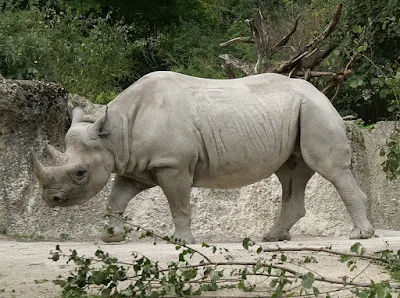20+ Interesting Facts About Rhinos
- Rhinoceros, also known as rhino, belong to the mammalian order of odd-toed ungulate. Their closest relatives are horses, zebras, and tapirs. The feet and feeding habits of these animals are similar. (Source)
- There are five species of rhinos. Two of these (white rhino and black rhino) are present in Africa, while the other three species (Indian rhino, Sumatran rhino, and Javan rhino) are in Asia. The white rhino and the Indian rhino (both can weigh up to 2,700 kg) are the largest species in Africa and Asia, respectively. Sumatran rhino (maximum weight of 1,000 kg) is the smallest of all rhino species. (Source)
- There were 500,000 rhinos in Asia and Africa at the beginning of the 20th Century. Currently, only 29,000 rhinos remain in the wild. Black rhinos, Javan rhinos, and Sumatran rhinos are critically endangered. On the contrary, the number of Indian rhinos has increased from 200 at the start of the 20th Century to 3,700 today. (Source)
- Rhinos have been present on earth for 50 million years. The largest-ever rhino species (5m tall with 20 tons of weight) was also the largest land mammal ever to live on earth. This giant rhino was present on earth around 30 million years ago. (Source)
- There is a mutually beneficial relationship between rhinos and red-billed oxpeckers. These birds get their food by eating parasites from rhinos (and many other mammals). In return, the oxpecker alarms rhinos from approaching humans (including poachers). (Source)
- All species of rhinos have herbivore diets. They eat grasses, leaves, stems, fruits, and other plants available in their habitat.
- Rhinos have smaller brains in relation to their bodies. Their brain weighs between 400 and 600 grams. But despite this tiny brain, rhinos are intelligent and can be trained like dogs.
- The longest-ever recorded rhino horn was 59 inches long and belonged to a white rhino. It was discovered in the 19th Century.
- All rhino species have thick but sensitive skin. The thickness of the skin helps prevent serious injuries. Rhinos roll in mud to protect their sensitive skin from sunburns and insect bites. (Source)
- White rhinos, black rhinos, and Sumatran rhinos have two horns each. Indian and Javan rhinos have one horn.
- Rhino horns are made of keratin, and their structure is similar to a horse’s hooves and a turtle’s beak. These horns are the main attraction behind rhino poaching. According to traditional Chinese medicine, horns can treat fever, gout, snakebite, typhoid, headaches, and other medical conditions. There are also unproven claims that it is a sexual stimulant. The largest market for rhino horns is in Vietnam. (Source)
- Adult rhinos have almost no natural predators (except Nile crocodiles). Young rhinos can fall prey to big cats (especially lions and tigers), African wild dogs, and crocodiles.
- Rhinos can defend themselves by using their horns, high speed (up to 30 mph), and strong senses of hearing and smell. On the contrary, their eyesight is weak. (Source)
- According
to statistics, poachers kill hundreds of rhinos every year. The
numbers reached their peak in 2014 when 1,215 rhinos were killed. Now, there
is a downward trend in rhino poaching, and less than 600 rhinos perished in
2019 across the globe. (Source)

Black rhino is the fastest among rhinos - Despite having enormous weight, rhinos can run very swiftly. African rhinos are faster than their Asian counterparts. White rhinos can reach a speed of 31 mph (50 km/h), while the maximum speed of a black rhino is 34 mph (55 km/h). (Source)
- Rhinos communicate through various methods. They do so by vocalizations (squeaks, snorts, growls, etc.), infrasonic communication, breath, scent (dung piles), and body language. (Source)
- Infighting between rhinos also happens. Male rhinos usually fight during the mating season, which can result in deaths.
- Despite their contrasting names, the body color of both black and white rhinos is quite similar. Both these species have grayish-brown color.
- Indian rhinos can swim and may dive underwater for food. However, rhinos in Africa can drown in deep water. They roll in mud to remain cool.
- Rhinos were once present in Europe. Several cave paintings provide evidence for their presence in this continent.
- The lifespan for various species of rhinos is from 35 to 50 years. Some rhinos die early in captivity due to their sensitivity to humans.
- Rhinos are usually solitary animals. Males only form a bond with females for mating. Male rhinos mark their territory by using their dung and urine.



Comments
Post a Comment